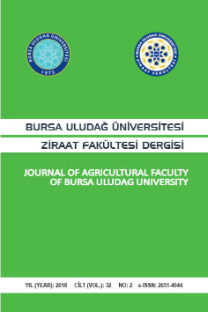Etlerde antibiyotik kalıntılarının aranması üzerinde çalışmalar
Araştırma, sığır ve kanatlı hayvanlarda tedavi, koruyucu ve verim artışı sağlamak için kullanılan oksitetrasiklin (OTC), kloramfenikol (CAP) ve çinko basitrasin'in (ZnB) bu hayvanlara ait çeşitli dokulardaki (kas, karaciğer, böbrek ve dalak) kalıntılarını belirlemek ve farklı yöntemlerin (üçlü plak ve disk diffüzyon) kullanılabilirliğinin karşılaştırılması amacıyla yapılmıştır. Araştırma deneysel (tavuk) ve tarama (sığır ve tavuk) olmak üzere iki farklı aşamada gerçekleştirilmiştir. Deneylerde duyarlı test suşları olarak OTC, CAP ve ZnB için B. cereus mycoides ATCC (9341), Micrococ. flavus ATCC (10240) ve B. megaterium ATCC (5117) kullanıldı.. İstatiksel değerlendirme sonuçları araştırmada kullanılan yöntemlerin her ikisinde de oluşan zonların arasındaki yöntemlerin her ikisinde farkın önemsiz (U=P>0. 05), ancak kas, karaciğer, böbrek ve dalak dokularındaki kalıntıların plakta oluşturdukları zonların arasındaki farkın önemli (KW=17, PO.05) olduğu saptanmıştır. Analiz çalışmaları sonucu Ankara Et ve Balık Kurumundan temin edilen 50 adet sığırın 7 sinde (%14) böbrek dokularında OTC kalıntıları saptanmıştır. Tavukların kas, karaciğer, böbrek ve dalak dokularında ise OTC, CAP ve ZnB kalıntıları görülmemiştir. Sonuç olarak, sığır ve kanatlı hayvanlara ait dokularda antibiyotik kalıntılarının varlığını tespit etmek amacıyla aralarında önemli fark tespit edilmeyen üçlü plak ve disk diffüzyon tekniklerinden birinin kesim öncesi ve/veya sonrası kullanılmasının halk sağlığı açısından yararlı olacağı görüşüne varılmıştır.
Anahtar Kelimeler:
analitik yöntemler, buzağı, et kalitesi, çinko basitrasin, kloramfenikol, ilaç kalıntıları, gıda güvenirliği, et muayenesi, oksitetrasiklin
Studies in the detection of antibiotic residues in meat
The study has been carried out in an attempt to determine residues in various tissues (muscle, liver, kidney and spleen) of the animals Oxytetracycline (OTC), Chloramphenicol (CAP) and Zinc Bacitracin (ZnB) which are used in treatment, prophylactic, and to increase productivity; and also to compare the applicability of the methods (Three Plate Test and Disc Diffusion Test). The study has been done in two different stages through experimental (chickens) and surveying (cattle and chickens). In the experiments as the sensitive microorganism to OTC, CAP, ZnB, B. cereus mycoides ATCC (11778), Sarcina lutea ATCC (9341), Micrococ. flavus ATCC (10240) and B. megaterium ATCC (5117) were used. The statistical values of the results show that in the both of the methods used in the research, the difference between the inhibition zones is of little importance (U=P>0.05) but the difference of the inhibition zones formed on the plate by, the residues located in the muscle, liver, kidney and spleen is important (KW=17, PO.05). At the end of the analysis, OTC residues were found only in the kidney tissues of 7 calves out of 50 calves got from. Ankara Meat and Fish Institution at the rate of 14 percent. Yet no residue of OTC, CAP and ZnB was seen in the liver, kidney, spleen, muscle tissues of the chicken. In conclusion, it has been agreed that, in order to detect the presence of the antibiotic residues in the tissues of cattle and chickens, one of the methods of the three plate or disc diffusion - between which there hasn't been a marked difference observed - should be applied for the benifit of the public health.
Keywords:
analytical methods, calves, meat quality, zinc bacitracin, chloramphenicol, drug residues, food safety, meat inspection, oxytetracycline,
- ISSN: 1301-3173
- Yayın Aralığı: Yılda 2 Sayı
- Başlangıç: 1981
- Yayıncı: Ahmet Akkoç
Sayıdaki Diğer Makaleler
Cobb ırkı broylerde karkas ağırlığının bazı kemiklerin gelişimlerine etkisinin incelenmesi
Abort yapan inekte kan değerlerinin incelenmesi
H. Hüseyin ORUÇ, Selahattin CEYLAN
Functional forms of the muscle bundles belong to external eye muscles in human and sheep
BAHRİ YILDIZ, HÜSEYİN YILDIZ, İhsaniye İKİZ
Hıdır DEMİR, MUSTAFA ÖZCAN, FERHAN KAYGISIZ, İsmail ABAŞ, BÜLENT EKİZ
Sığır pankreaslarındaki glaktoz rezidülerinin mistellektin-1 ile saptanması
Tavuk ve hindilerde turkey rhinotracheitis virus (TRTV) antikorlarının ELISA ile belirlenmesi
Etlerde antibiyotik kalıntılarının aranması üzerinde çalışmalar
İvesi koyunlarında flushing ve sinkronizasyon uygulamalarının döl verimi üzerine etkisi
